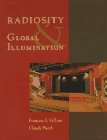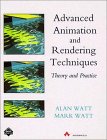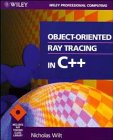
(June 1999)
Rendering realistic 3D images in a fraction of a second is an important goal in today's computer graphics industry. With the timely publication of "Real-Time Rendering," authors Tomas Möller and Eric Haines present algorithms of lasting value, for use in computer-aided design, simulation, virtual reality worlds, and games. Focusing on the graphics pipeline, the book has chapters on transforms, optimization, visual appearance, polygon manipulation, collision detection, and special effects. Also included are a wide range of texture algorithms, intersection methods, and speed-up techniques. The book concludes with a section on hardware, including case studies of various graphics systems. Appendices on linear algebra and trigonometry give concise summaries for these fields. Copious references, reading recommendations, and a dedicated web site for additional resources make this book an indispensable guide in this rapidly evolving field.

(June 2000)
Ray tracing is an innovative, effective method of producing photorealistic three-dimensional computer graphics images by applying simple algorithms. It works using the theory that one can model reflection and refraction by tracing the path of light rays as they "bounce" through an environment. Realistic Ray Tracings is a unique and invaluable contribution for graphics programmers seeking to write their own ray tracing programs as Peter Shirley takes them through the steps of creating their own ray tracing programs ranging from simple images through advanced special effects. Readers will be able to build up their ray tracer one step at a time, chapter by chapter. Realistic Ray Tracings also provides the details necessary to add special effects such as soft shadows, gall and metal textures, indirect lighting, depth-of-field, and motion blur. Those seeking to develop realistic three-dimensional computer graphics, should begin with a careful reading of Peter Shirley's Realistic Ray Tracings!

(August 1994)
Presents some of the most recent research in the radiosity method, a simulation technique for radiant energy transfer, and global illumination algorithms, and provides a theoretical presentation of the various radiosity algorithms. Includes 93 illustrations and 45 color plates, and information on design issues for the development of global illumination software. Useful for computer graphics researchers, students, and programmers with some prior knowledge of computer graphics or simulation. Annotation copyright Book News, Inc. Portland, Or.

(August 1989)
The creation of ever more realistic 3D images is central to the development of computer graphics. Ray tracing is one of the most popular and powerful means by which photo-realistic images can now be created. From fundamental principles to advanced applications, this guide provides how-to procedures and a detailed understanding of the scientific foundations of ray tracing. Richly illustrated with color and b&w plates.

(November 1992)
An exposition of state-of-the-art techniques in rendering and animation. This book provides a unique synthesis of techniques and theory. Each technique is illustrated with a series of full-color frames showing the development of the example. Features contains a wealth of practical implementation detail includes practical algorithms backed up by details of their implementation using RenderMan all animation techniques based around real case studies of commercially produced work includes 36 pages of color images. Advanced Animation and Rendering Techniquesoffers a balance between theoretical concepts and implementational detail that will be invaluable to professional programmers and students alike.

(August 1993)
A comprehensive look at the radiosity method for image synthesis and the tools required to approach this elusive goal. Basic concepts and mathematical fundamentals underlying image synthesis and radiosity algorithms are covered thoroughly. There are 16 pages of full-color images and over 100 illustrations to explain the development and show the results of the radiosity method.

(December 1993)
This is the first ray tracing book to focus on object-oriented methods that can greatly enhance both the speed of processing and the quality of the resulting graphics. It includes a brief introduction to ray tracing and background on advanced topics such as acceleration techniques, texture, mapping, soft shadowing, and translucency.

(July 2001)
The creation of realistic three-dimensional images is central to computer graphics. Photon mapping, an extension of ray tracing, makes it possible to efficiently simulate global illumination in complex scenes. Photon mapping can simulate caustics (focused light, such as shimmering waves at the bottom of a swimming pool), diffuse inter-reflections (e.g., the bleeding of colored light from a red wall onto a white floor, giving the floor a reddish tint), and participating media (e.g., clouds or smoke). This book is a practical guide to photon mapping; it provides both the theory and the practical insight necessary to implement photon mapping and simulate all types of direct and indirect illumination efficiently.

(July 2001)
Many computer graphics researchers are exploring non-photorealistic rendering techniques as an alternative to realistic rendering. Defined by what it is not, non-photorealistic rendering brings art and science together, concentrating less on the process and more on communicating the content of an image. Techniques that have long been used by artists can be applied to computer graphics to emphasize subtle attributes, and to omit extraneous information. This book provides an overview of the published research on non-photorealistic rendering in order to categorize and distill the current research into a body of usable techniques. A summary of non-photorealistic rendering algorithms, as well as pseudo-code for producing some of the images, is included.